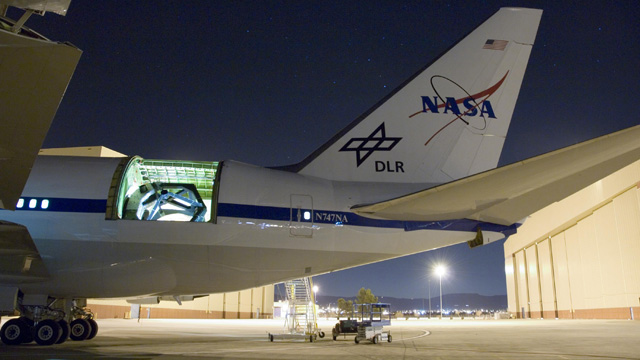SOPHIA—the Stratospheric Observatory for Infrared Astronomy—is a telescope unlike any other. It's not mounted to the Earth's surface. And it's not floating in space. Instead, SOPHIA travels the skies, rigged up to a dedicated 747 flying at 40,000 feet.
The idea is to have a telescope that gets a better view than the ones on the ground, but is easier to fix and update than space-based Hubble. It flies twice a week, on overnight trips. Reporter Lauren Sommer, from radio KQED, San Francisco, got to ride along on a recent flight. You can listen to her story, or read about the experience, at the site for KQED's QUEST science and environment series.
The researchers take advantage of the nighttime sky, so we left at dusk for 10-hour tour flying zigzags across the Pacific Ocean. Each leg of the journey is carefully calculated so the telescope can pinpoint a far away star. The plane interior is packed with computers and equipment. It also lacks insulation since much of it was removed to install the telescope, so it's both cold and loud inside.
At four in the morning, the astronomers are still hard at work. If they're as tired as I am, they certainly aren't showing it.
"For me, this is very exciting," says Ian McLean, a professor at the University of California-Los Angeles. He usually works on the ground. "All my career has been ground-based astronomy. So, it's only my second flight."
McLean says there's a good reason to do astronomy in the stratosphere. The atmosphere is thinner, which means it's easier for the telescope to see the stars. "It's almost as good as space," says McLean. "Not quite, but almost."And unlike the Hubble Space Telescope, this telescope lands everyday, which means the scientists can update and fix the equipment. "By the time you get a mission into orbit, the technology you're using is relatively old. Here we can stay state of the art all the time," says McLean. NASA began developing SOFIA in 1997 and almost cancelled the project at one point. It flew its first science mission in November 2010 and now costs about $80 million a year to operate.


No comments:
Post a Comment